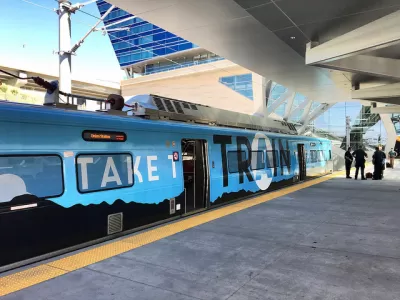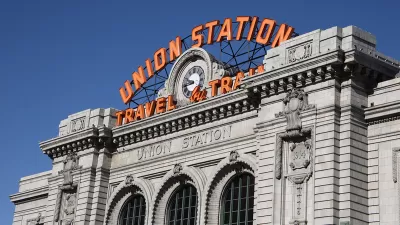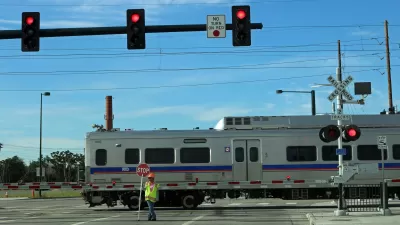Ridership on the electrified A Line, which opened to great fanfare on Earth Day, reached a weekday average of 16,910 as of June 5. The 23-mile line operates from Union Station to Denver International Airport. Not all is perfect though.

The University of Colorado A Line "enjoys an on-time performance average of 89 percent, said Dave Genova, Regional Transportation District’s general manager," writes Monte Whaley, Denver Post reporter covering transportation. "And overall ridership during its sixth week of operation — from May 30 to June 5 — hit a new weekday average of 16,910."
Genova admitted there were “things we did not see in testing. And I’m not satisfied with our performance as it is,” he said.
The record ridership makes the 23-mile line the 11th busiest commuter rail line in the U.S., just after the 83-mile UTA Frontrunner commuter line that opened in 2008, according to March 2016 data from the American Public Transportation Association via Wikipedia.
Ridership would appear to be influenced by passenger traffic at DIA, which surged in April.
However, some Regional Transportation District (RTD) board members are nonetheless concerned about operation problems which have surfaced, writes Whaley. For the second time since service began on April 22, lightning strikes halted service for about two hours on June 13.
Grade Crossings
While the A Line has some of the operating features of heavy rail, such as operating frequency, hours of operation, and level boarding, not all grade crossings are separated, and that can create problems when power is lost, such as during lightning strikes.
"RTD workers are still at 10 train crossings along the A-Line route to make sure gates are working properly, said RTD spokesman Nate Currey [on June 13].
More extensive problems at the crossings, which are also used by Union Pacific Railroad, particularly with the crossing gates, were detailed by Whaley and Denver Post staff writer John Aguilar last month.
Positive Train Control
"RTD board chair Tom Tobiassen said the new technology being used on the A-Line — including Positive Train Control (PTC) to prevent derailments or collisions — is a challenge to implement," wrote Whaley and Aguilar.
“We are the only transit agency that has Positive Train Control built into its system, everybody is watching what we do,” Tobiassen said [May 10]. “Everybody is going to learn a lot from this.”
Extra costs incurred at the grade crossings appear to be borne by Denver Transit Partners, the private partner in RTD's successful Eagle P3 Project, the nation's first full public-private partnership for transit.
Look for RTD's second commuter line, the 6-mile, Northwest B Line from Union Station to Westminster Station, to begin service on July 25, 2016.
Hat tip to Annie Dawid.
FULL STORY: Union Station-DIA train criticized by RTD board

Study: Maui’s Plan to Convert Vacation Rentals to Long-Term Housing Could Cause Nearly $1 Billion Economic Loss
The plan would reduce visitor accommodation by 25,% resulting in 1,900 jobs lost.

North Texas Transit Leaders Tout Benefits of TOD for Growing Region
At a summit focused on transit-oriented development, policymakers discussed how North Texas’ expanded light rail system can serve as a tool for economic growth.

Why Should We Subsidize Public Transportation?
Many public transit agencies face financial stress due to rising costs, declining fare revenue, and declining subsidies. Transit advocates must provide a strong business case for increasing public transit funding.

How to Make US Trains Faster
Changes to boarding platforms and a switch to electric trains could improve U.S. passenger rail service without the added cost of high-speed rail.

Columbia’s Revitalized ‘Loop’ Is a Hub for Local Entrepreneurs
A focus on small businesses is helping a commercial corridor in Columbia, Missouri thrive.

Invasive Insect Threatens Minnesota’s Ash Forests
The Emerald Ash Borer is a rapidly spreading invasive pest threatening Minnesota’s ash trees, and homeowners are encouraged to plant diverse replacement species, avoid moving ash firewood, and monitor for signs of infestation.
Urban Design for Planners 1: Software Tools
This six-course series explores essential urban design concepts using open source software and equips planners with the tools they need to participate fully in the urban design process.
Planning for Universal Design
Learn the tools for implementing Universal Design in planning regulations.
City of Santa Clarita
Ascent Environmental
Institute for Housing and Urban Development Studies (IHS)
City of Grandview
Harvard GSD Executive Education
Toledo-Lucas County Plan Commissions
Salt Lake City
NYU Wagner Graduate School of Public Service




























